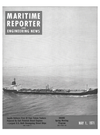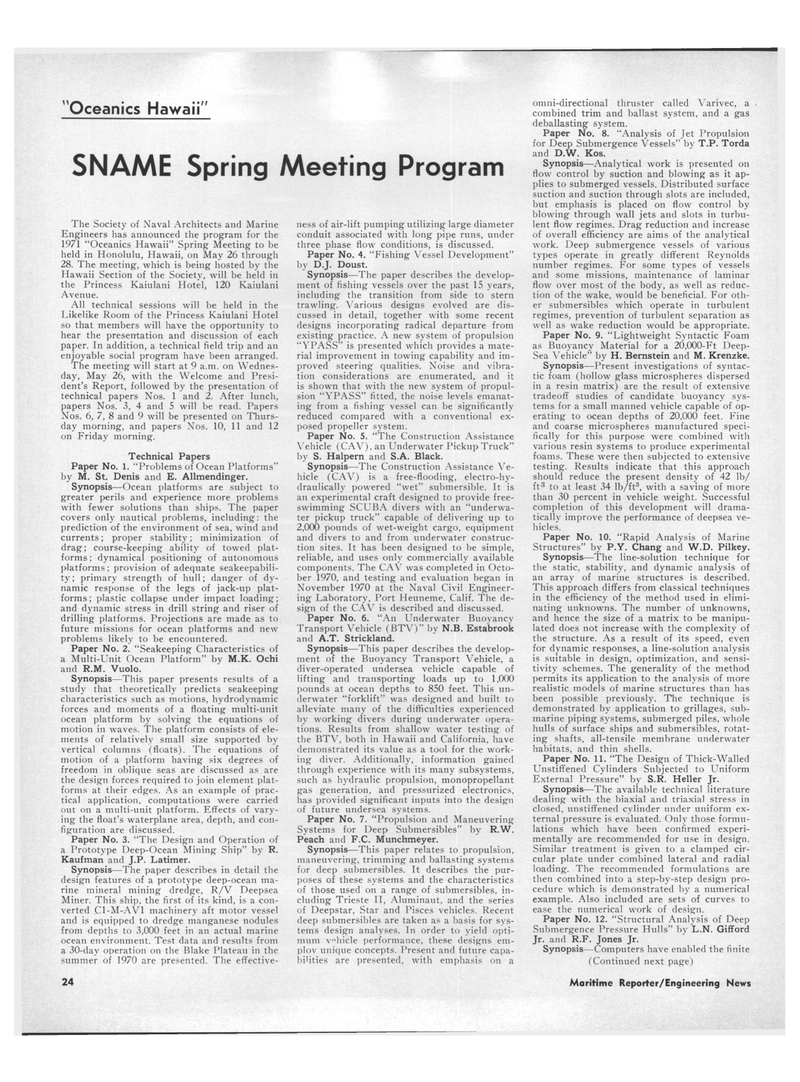
Page 20: of Maritime Reporter Magazine (May 1971)
Read this page in Pdf, Flash or Html5 edition of May 1971 Maritime Reporter Magazine
"Oceanics Hawaii"
SNAME Spring Meeting Program
The Society of Naval Architects and Marine
Engineers has announced the program for the 1971 "Oceanics Hawaii" Spring Meeting to be held in Honolulu, Hawaii, on May 26 through 28. The meeting, which is being hosted by the
Hawaii Section of the Society, will be held in the Princess Kaiulani Hotel, 120 Kaiulani
Avenue.
All technical sessions will be held in the
Likelike Room of the Princess Kaiulani Hotel so that members will have the opportunity to hear the presentation and discussion of each paper. In addition, a technical field trip and an enjoyable social program have been arranged.
The meeting will start at 9 a.m. on Wednes- day, May 26, with the Welcome and Presi- dent's Report, followed by the presentation of technical papers Nos. 1 and 2. After lunch, papers Nos. 3, 4 and 5 will be read. Papers
Nos. 6, 7, 8 and 9 will be presented on Thurs- day morning, and papers Nos. 10, 11 and 12 on Friday morning.
Technical Papers
Paper No. 1. "Problems of Ocean Platforms" by M. St. Denis and E. Allmendinger.
Synopsis—Ocean platforms are subject to greater perils and experience more problems with fewer solutions than ships. The paper covers only nautical problems, including: the prediction of the environment of sea, wind and currents; proper stability; minimization of drag; course-keeping ability of towed plat- forms; dynamical positioning of autonomous platforms; provision of adequate seakeepabili- ty; primary strength of hull; danger of dy- namic response of the legs of jack-up plat- forms; plastic collapse under impact loading; and dynamic stress in drill string and riser of drilling platforms. Projections are made as to future missions for ocean platforms and new problems likely to be encountered.
Paper No. 2. "Seakeeping Characteristics of a Multi-Unit Ocean Platform" by M.K. Ochi and R.M. Vuolo.
Synopsis—This paper presents results of a study that theoretically predicts seakeeping characteristics such as motions, hydrodynamic forces and moments of a floating multi-unit ocean platform by solving the equations of motion in waves. The platform consists of ele- ments of relatively small size supported by vertical columns (floats). The equations of motion of a platform having six degrees of freedom in oblique seas are discussed as are the design forces required to join element plat- forms at their edges. As an example of prac- tical application, computations were carried out on a multi-unit platform. Effects of vary- ing the float's waterplane area, depth, and con- figuration are discussed.
Paper No. 3. "The Design and Operation of a Prototype Deep-Ocean Mining Ship" by R.
Kaufman and J.P. Latimer.
Synopsis—The paper describes in detail the design features of a prototype deep-ocean ma- rine mineral mining dredge, R/V Deepsea
Miner. This ship, the first of its kind, is a con- verted C1-M-AV1 machinery aft motor vessel and is equipped to dredge manganese nodules from depths to 3,000 feet in an actual marine ocean environment. Test data and results from a 30-day operation on the Blake Plateau in the summer of 1970 are presented. The effective- ness of air-lift pumping utilizing large diameter conduit associated with long pipe runs, under three phase flow conditions, is discussed.
Paper No. 4. "Fishing Vessel Development" by D.J. Doust.
Synopsis—The paper describes the develop- ment of fishing vessels over the past 15 years, including the transition from side to stern trawling. Various designs evolved are dis- cussed in detail, together with some recent designs incorporating radical departure from existing practice. A new system of propulsion "YPASS" is presented which provides a mate- rial improvement in towing capability and im- proved steering qualities. Noise and vibra- tion considerations are enumerated, and it is shown that with the new system of propul- sion "YPASS" fitted, the noise levels emanat- ing from a fishing vessel can be significantly reduced compared with a conventional ex- posed propeller system.
Paper No. 5. "The Construction Assistance
Vehicle (CAV), an Underwater Pickup Truck" by S. Halpern and S.A. Black.
Synopsis—The Construction Assistance Ve- hicle (CAV) is a free-flooding, electro-hy- draulically powered "wet" submersible. It is an experimental craft designed to provide free- swimming SCUBA divers with an "underwa- ter pickup truck" capable of delivering up to 2,000 pounds of wet-weight cargo, equipment and divers to and from underwater construc- tion sites. It has been designed to be simple, reliable, and uses only commercially available components. The CAV was completed in Octo- ber 1970, and testing and evaluation began in
November 1970 at the Naval Civil Engineer- ing Laboratory, Port Heuneme, Calif. The de- sign of the CAV is described and discussed.
Paper No. 6. "An Underwater Buoyancy
Transport Vehicle (BTV)" by N.B. Estabrook and A.T. Strickland.
Synopsis—This paper describes the develop- ment of the Buoyancy Transport Vehicle, a diver-operated undersea vehicle capable of lifting and transporting loads up to 1,000 pounds at ocean depths to 850 feet. This un- derwater "forklift" was designed and built to alleviate many of the difficulties experienced by working divers during underwater opera- tions. Results from shallow water testing of the BTV, both in Hawaii and California, have demonstrated its value as a tool for the work- ing diver. Additionally, information gained through experience with its many subsystems, such as hydraulic propulsion, monopropellant gas generation, and pressurized electronics, has provided significant inputs into the design of future undersea systems.
Paper No. 7. "Propulsion and Maneuvering
Systems for Deep Submersibles" by R.W.
Peach and F.C. Munchmeyer.
Synopsis—This paper relates to propulsion, maneuvering, trimming and ballasting systems for deep submersibles. It describes the pur- poses of these systems and the characteristics of those used on a range of submersibles, in- cluding Trieste II, Aluminaut, and the series of Deepstar, Star and Pisces vehicles. Recent deep submersibles are taken as a basis for sys- tems design analyses. In order to yield opti- mum vehicle performance, these designs em- ploy unique concepts. Present and future capa- bilities are presented, with emphasis on a omni-directional thruster called Varivec, a combined trim and ballast system, and a gas deballasting system.
Paper No. 8. "Analysis of Jet Propulsion for Deep Submergence Vessels" by T.P. Torda and D.W. Kos.
Synopsis—Analytical work is presented on flow control by suction and blowing as it ap- plies to submerged vessels. Distributed surface suction and suction through slots are included, but emphasis is placed on flow control by blowing through wall jets and slots in turbu- lent flow regimes. Drag reduction and increase of overall efficiency are aims of the analytical work. Deep submergence vessels of various types operate in greatly different Reynolds number regimes. For some types of vessels and some missions, maintenance of laminar flow over most of the body, as well as reduc- tion of the wake, would be beneficial. For oth- er submersibles which operate in turbulent regimes, prevention of turbulent separation as well as wake reduction would be appropriate.
Paper No. 9. "Lightweight Syntactic Foam as Buoyancy Material for a 20,000-Ft Deep-
Sea Vehicle" by H. Bernstein and M. Krenzke.
Synopsis—Present investigations of syntac- tic foam (hollow glass microspheres dispersed in a resin matrix) are the result of extensive tradeoff studies of candidate buoyancy sys- tems for a small manned vehicle capable of op- erating to ocean depths of 20,000 feet. Fine and coarse microspheres manufactured speci- fically for this purpose were combined with various resin systems to produce experimental foams. These were then subjected to extensive testing. Results indicate that this approach should reduce the present density of 42 lb/ ft3 to at least 34 lb/ft3, with a saving of more than 30 percent in vehicle weight. Successful completion of this development will drama- tically improve the performance of deepsea ve- hicles.
Paper No. 10. "Rapid Analysis of Marine
Structures" by P.Y. Chang and W.D. Pilkey.
Synopsis—The line-solution technique for the static, stability, and dynamic analysis of an array of marine structures is described.
This approach differs from classical techniques in the efficiency of the method used in elimi- nating unknowns. The number of unknowns, and hence the size of a matrix to be manipu- lated does not increase with the complexity of the structure. As a result of its speed, even for dynamic responses, a line-solution analysis is suitable in design, optimization, and sensi- tivity schemes. The generality of the method permits its application to the analysis of more realistic models of marine structures than has been possible previously. The technique is demonstrated by application to grillages, sub- marine piping systems, submerged piles, whole hulls of surface ships and submersibles, rotat- ing shafts, all-tensile membrane underwater habitats, and thin shells.
Paper No. 11. "The Design of Thick-Walled
Unstiffened Cylinders Subjected to Uniform
External Pressure" by S.R. Heller Jr.
Synopsis—The available technical literature dealing with the biaxial and triaxial stress in closed, unstiffened cylinder under uniform ex- ternal pressure is evaluated. Only those formu- lations which have been confirmed experi- mentally are recommended for use in design.
Similar treatment is given to a clamped cir- cular plate under combined lateral and radial loading. The recommended formulations are then combined into a step-by-step design pro- cedure which is demonstrated by a numerical example. Also included are sets of curves to ease the numerical work of design.
Paper No. 12. "Structural Analysis of Deep
Submergence Pressure Hulls" by L.N. Gifford
Jr. and R.F. Jones Jr.
Synopsis—Computers have enabled the finite (Continued next page) 24 Maritime Reporter/Engineering News

 19
19

 21
21
